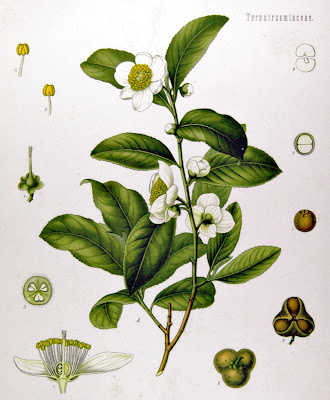The Science of Chinese Tea
 There are two kinds of plants for tea-making. Camellia Assamica is a kind of tall trees with large leaves. Grown in India and Southwest China, these leaves are suitable for making black tea. Green tea or oolong tea is from leaves of Camellia Sinensis, small leaf shrubs that thrive in East Asia, although these delicate leaves are great for making all kinds of tea.
There are two kinds of plants for tea-making. Camellia Assamica is a kind of tall trees with large leaves. Grown in India and Southwest China, these leaves are suitable for making black tea. Green tea or oolong tea is from leaves of Camellia Sinensis, small leaf shrubs that thrive in East Asia, although these delicate leaves are great for making all kinds of tea.
Green tea is an unfermented tea. Fresh leaves were harvested when they were tender, then laid out in the air for a while to reduce moisture. The withered leaves are rolled or pressed into shapes, then heated dry to form the final products. Because it is unfermented, green tea is the best when fresh. During the drying process, flower tea can be created by adding fragrant flowers.
Black tea is completely fermented tea. After the withering process, tea leaves were piled together and kept warm for a fermenting process. Completely fermented leaves are then dried to form the final products. Because they are fermented, black tea has a longer shelf life. A Pu-erh tea brick can be great 10 to 15 years after it was made, like aged wine or cheese.
Oolong tea was an invention by mistake. The process started with green tea making. However, because of bad weather, the leaves became partially fermented before they were dried. It gave tea leaves a unique flavor. In Chinese, "oolong" means a mistake.
Those are pure tea leaves without added flavor. The Chinese flower tea is not herb tea, but tea leaves infused with flower fragrance during the heating process. The most well known is jasmine tea. My aunt used to run a jasmine garden in Fujian province. They got up at 5 am to pick jasmine flower buds to finish before 10 am. Or the jasmine flowers will fully blossom, and the fragrant will be gone. The jasmine flowers were immediately taken to the tea shop next door and mixed with tea leaves for a lengthy heating and drying process.
"Listen, you will not see a single jasmine flower in the best jasmine tea because they remove the dried flowers at the final step." said my aunt, "If you see many flowers in jasmine tea, it is likely to be fake. People add chemical fragrance and mix in some dry flowers."
(Photo Credit: Tea plant (Camellia sinensis) from Köhler's Medicinal Plants, 1897)

Comments
Post a Comment